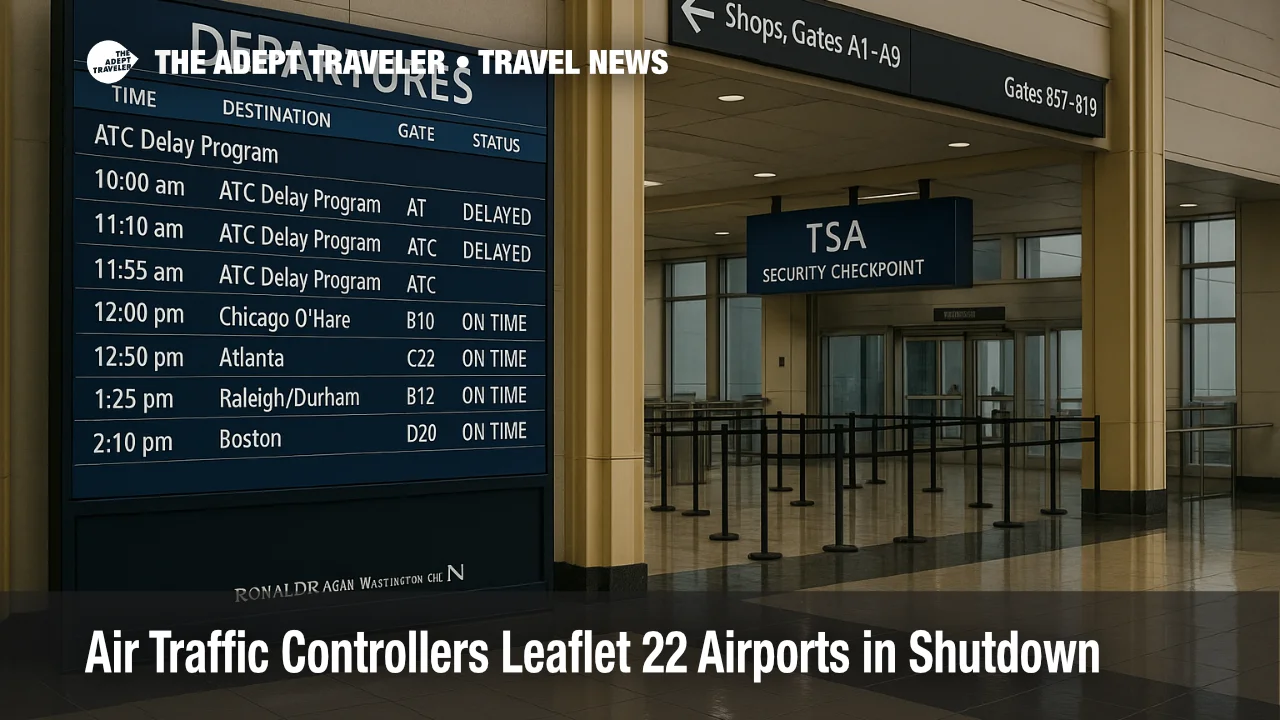Air Traffic Controllers Leaflet 22 Airports in Shutdown

Impact
- Who Is Affected
- Travelers flying through major U.S. hubs where staffing shortfalls can trigger ground stops and flow programs
- What To Expect
- More frequent ATC delay programs and sporadic ground stops at busy facilities even in fair weather
- When It Matters
- Peak periods and the days following missed paychecks tend to show the sharpest staffing-related impacts
- Where To Watch
- Hubs cited by FAA and DOT in recent days include Los Angeles, Newark, Reagan National and Chicago O'Hare
- What To Do Next
- Monitor your flight status, build extra connection time, and review your airline's waiver or reaccommodation options before departure
Air traffic controllers across the United States handed out leaflets at 22 airports on October 28, the day many missed their first full paycheck since the federal government shutdown began. The National Air Traffic Controllers Association (NATCA) said the outreach aimed to explain how unpaid work and ongoing staffing gaps can weaken efficiency and introduce risk in the National Airspace System. Union leadership emphasized controllers will not stage any job action, which is illegal, but urged an immediate end to the shutdown. For travelers, the message is straightforward: expect more staffing-driven delays and plan accordingly.
National Air Traffic Controllers Association (NATCA) update
NATCA identified the 22 airports where members leafleted, spanning the nation from Hartsfield-Jackson Atlanta to Seattle-Tacoma and Boston Logan International Airport (BOS). The union's materials underscore that controllers, classed as essential employees, must work without pay until the government reopens. NATCA President Nick Daniels, elected in 2024, reiterated that controllers will continue reporting for duty while pressing policymakers to resolve the impasse.
Latest developments
Transportation Secretary Sean Duffy said staffing shortfalls have rapidly become a primary driver of delays. On Sunday, 44 percent of FAA-imposed delays were tied to controller absences, and 24 percent on Monday, compared with about 5 percent in a normal period. Over the weekend, FAA traffic initiatives and a temporary ground stop at Los Angeles International followed staffing issues at a Southern California facility; delay programs also hit Newark Liberty, Reagan National, and Chicago O'Hare. These localized constraints can ripple nationwide as flow-control measures reduce capacity at busy hubs.
Analysis
For travelers, the operational pattern is clear: when controller staffing dips, facilities introduce ground delay programs, miles-in-trail restrictions, and, in acute cases, short ground stops. Unlike weather, these constraints can appear in otherwise good conditions and may concentrate around peak banks at major hubs. If you have a tight connection, add buffer time or rebook to a longer connection where possible. Same-day alternatives through less congested hubs may reduce exposure to flow constraints.
Background
Air traffic control staffing was below FAA targets even before the shutdown, with extended overtime and six-day weeks common at key facilities. A shutdown interrupts pay, training pipelines, and some certification activities, which compounds shortages and can elevate absenteeism. During the prolonged 2018-2019 shutdown, similar dynamics forced capacity reductions in the New York and Washington areas until pay resumed.
If you are traveling this week, check your airline app frequently, enable push alerts, and watch airport status programs. Our rolling operations update covers the latest ground delays and holds by airport and time block, which can help you decide whether to move to an earlier flight or a different connection point. See our running report: Flight Delays and Airport Impacts: October 28, 2025.
Final thoughts
The air traffic controllers shutdown story is shifting from a political standoff to a daily operational reality. With leafleting at 22 airports and DOT data showing a spike in staffing-driven delays, travelers should plan for irregular operations even on clear-sky days and prioritize flexibility while the shutdown persists.
Sources
- NATCA: Shutdown hub page and 22-airport leafleting notice, first-party
- NATCA leadership bio page for President Nick Daniels, first-party
- Reuters: Duffy cites 44% of delays Sunday, 24% Monday due to controller absences
- AP via AP News: LAX ground stop and broader staffing impacts during shutdown
- Reuters: Nationwide delays surge amid shutdown; FAA cites staffing impacts
- Travel Weekly: Controllers planned to hand out leaflets at 22 airports
